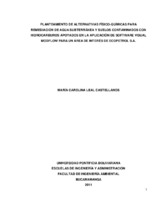| dc.contributor.advisor | Kopytko, María Irene | |
| dc.contributor.author | Leal Castellanos, María Carolina | |
| dc.coverage.spatial | Seccional Bucaramanga. Universidad Pontificia Bolivariana. Escuela de Ingenierías. Facultad de Ingeniería Ambiental | spa |
| dc.coverage.temporal | 2011 | |
| dc.date.accessioned | 2013-11-05T19:23:07Z | |
| dc.date.available | 2013-11-05T19:23:07Z | |
| dc.date.created | 2011-03-22 | |
| dc.date.issued | 2013-11-05 | |
| dc.identifier.uri | http://hdl.handle.net/20.500.11912/1240 | |
| dc.description | 157p.: (pdf); il; tablas; anexos | spa |
| dc.description.abstract | Este trabajo planteó alternativas físico-químicas para remediación de agua subterránea y suelos contaminados con hidrocarburos en Estación 1 y predio aledaño de Campo Palagua como primera fase de proyecto cual plantea la recuperación de esta zona. Inicialmente se realizó la caracterización físico-química de las aguas freáticas y suelos contaminados con hidrocarburos. El agua subterránea en los puntos de monitoreo de la Estación 1 y predio aledaño contenía fenoles y metales como el Bario, Plomo, Arsénico, Cromo hexavalente y Cadmio que superaron el límite permitido por la norma colombiana vigente en varios puntos de muestreo. Se encontró gran diferencia en valores de conductividad eléctrica, sólidos disueltos y cloruros presentes en aguas subterráneas entre los pozos de la Estación 1 (PM-10) y el predio aledaño (PM-18 y PM-19) como resultado del desplazamiento del agua hacia las partes bajas del terreno, correspondiente a la propiedad adjunta y la actividad ganadera que se establece en esta zona. Caracterización de los suelos de la Estación 1 y predio aledaño señalaron propiedades semejantes de los dos, clasificándolos como arenosos, lo cual coincide con la alta permeabilidad y rápida infiltración observada, junto con baja densidad relativa y baja retención de humedad. Además ambos presentan una capacidad de intercambio catiónico entre 11,6-15,8 meq/100g y estructura granular.La modelación del flujo de aguas subterráneas y la trayectoria de la pluma contaminante simularon un comportamiento esperado, al igual que los modelos realizados en los años 2008 y 2009, con la dirección de flujo Noroeste a Suroeste coincidiendo con la topografía del área de estudio. Se determinó en el mismo Software la trayectoria de partículas contaminantes en dirección Suroeste, pero con la velocidad del desplazamiento de flujo mucho mayor que en modelos anteriores. La alternativa planteada para la remediación de agua subterránea y suelo contaminado con hidrocarburo del predio aledaño a la Estación 1 de Campo Palagua, fue el lavado inicial del suelo con una solución de surfactante, seguido por la bioremediación por medio los microorganismos nativos. | spa |
| dc.description.abstract | This work proposed physicochemical alternatives for the remediation of groundwater and soils contaminated with hydrocarbons in the Station 1 and adjacent property of the Oil Field “Palagua”. This constitutes the first stage of the site’s proposed remediation project. Initially, a physicochemical characterization of the hydrocarbon contaminated soil and groundwater was performed. Groundwater in the monitoring wells of the Station 1 and adjacent property contained phenols and metals such as Barium, Lead, Arsenic, hexavalent Chromium and Cadmium which exceed, in several observation points, the limits established by the current Colombian regulations. Big differences in values of electrical conductivity, dissolved solids and chlorides present in groundwater were found between the Station 1 (PM-10) and adjacent property (PM-18 and 19) wells as a result of the water displacement towards the lower parts of the area and the cattle raising activity that is established in this zone. Characterization of the soils of Station 1 and adjacent property indicated similar properties. Soils were classified as sandy, which coincides with the observed high permeability and rapid infiltration, as well as the low relative density and low moisture retention. Also, both soils showed a cation exchange capacity between 11,6 – 15,8 meq/100 g and granular structure. The results of groundwater flow and contaminant particles modeling in Modflow were concurrent with modeling performed in 2008 and 2009; the direction of flow is Northwest to Southwest, coinciding with the topography of the area of study. The contaminant particles pathways were observed to be South-west but the speed of the flow displacement was greater than in previous models. The proposed alternative for the remediation of groundwater and soil contaminated with hydrocarbons at the adjacent property to the Station 1 of Field Palagua consists of an initial soil wash with a solution of a surfactant and the later bioremediation with native microorganisms. | |
| dc.language.iso | es | |
| dc.rights | Attribution-NonCommercial-NoDerivatives 4.0 International | * |
| dc.rights.uri | http://creativecommons.org/licenses/by-nc-nd/4.0/ | * |
| dc.subject | Tesis y disertaciones académicas | spa |
| dc.subject | Aguas subterráneas | spa |
| dc.subject | Ecopetrol S.A | spa |
| dc.subject | Contaminación de suelos | spa |
| dc.subject | Hidrocarburos | spa |
| dc.subject | Modflow - programa | spa |
| dc.title | Planteamiento de alternativas físico-químicas para remediación de agua subterrénea y suelos contaminados con hidrocarburos apoyados en la aplicación de software visual Modflow para un área de interés de Ecopetrol S.A | spa |
| dc.type | bacherlorThesis | spa |
| dc.rights.accessRights | openAccess | spa |
| dc.type.hasVersion | publishedVersion | spa |
| dc.identifier.instname | instname:Universidad Pontificia Bolivariana | spa |
| dc.identifier.reponame | reponame:Repositorio Institucional de la Universidad Pontificia Bolivariana | spa |
| dc.identifier.repourl | repourl:https://repository.unab.edu.co/ | |


